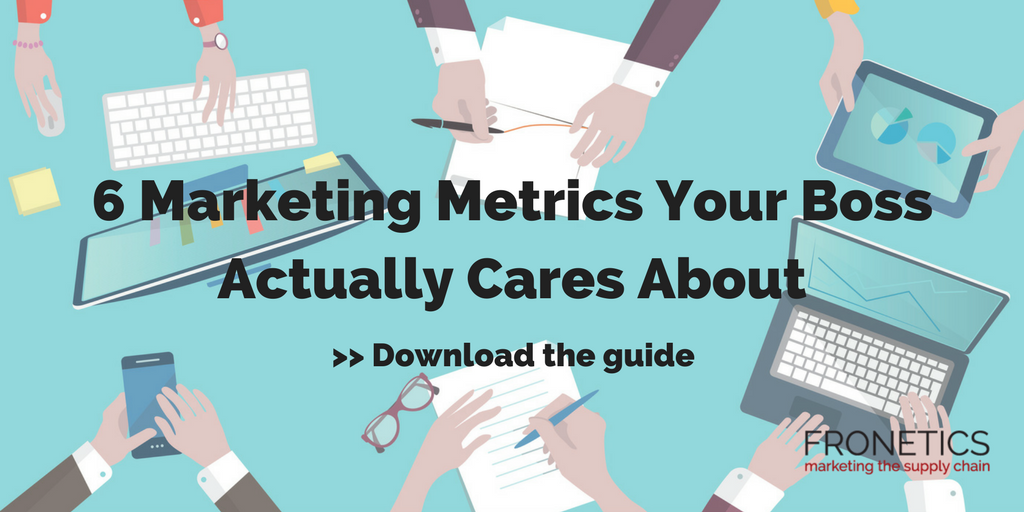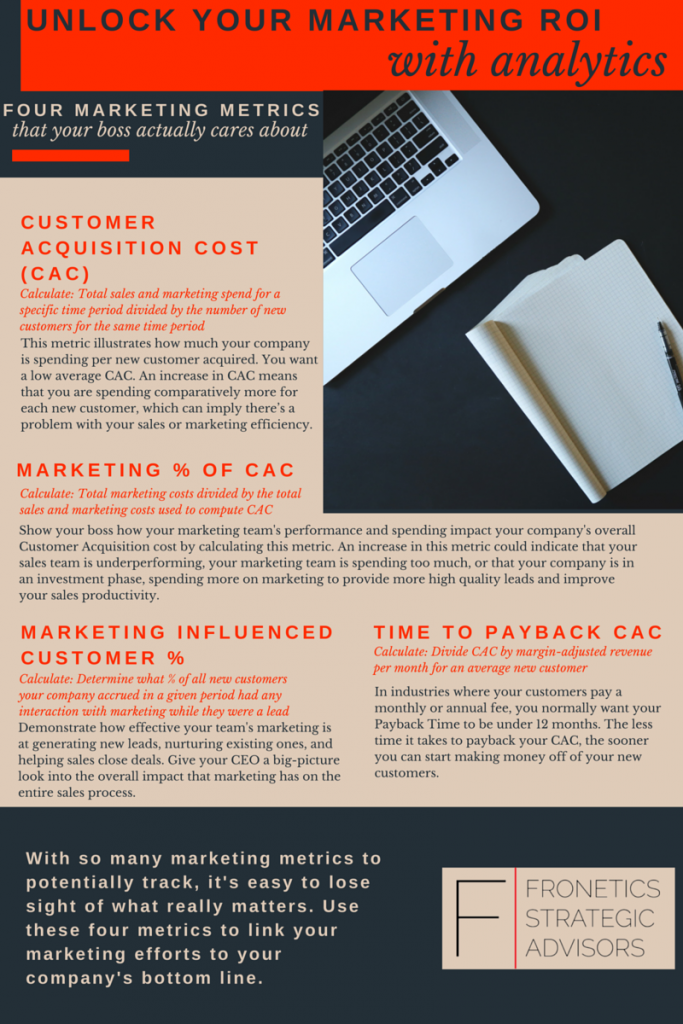
by Jennifer Hart Yim | Jan 6, 2025 | Data/Analytics, Marketing, Strategy
The C-suite demands more than vanity campaign metrics—they require clear evidence of marketing’s contribution to revenue growth, profitability, and market share expansion. The most successful supply chain marketers have mastered a crucial skill: translating marketing activities into the language of financial outcomes.
Bridging the Gap Between Marketing and Finance
How can you be sure, really sure, that you are demonstrating concrete business value to the C-suite? While traditional marketing metrics like engagement rates and lead generation are always top of mind for marketing folks, securing executive support is really about speaking the language of financial outcomes and business growth.
Why Supply Chain Marketing Metrics Need a Financial Bent
The disconnect between marketing activities and financial outcomes often creates skepticism among executive leadership. Marketers must change their reporting from activity-based metrics to revenue-focused outcomes. This shift isn’t just about changing terminology—it’s about fundamentally reframing how marketing creates measurable business value.
How to (Effectively) Demonstrate Supply Chain Marketing ROI
1. Prioritize ROI Over Activity Metrics
Transform your reporting approach from campaign-centric to outcome-focused. Instead of: “Our packaging technology campaign reached 100,000 decision-makers.” Say: “Our targeted campaign generated $3.2M in qualified pipeline opportunities, with a 4:1 return on marketing investment.”
2. Connect Supply Chain Marketing Metrics to Revenue
Develop clear links between marketing activities and financial outcomes:
- Calculate customer acquisition cost (CAC) reduction from targeted marketing campaigns
- Measure increases in average contract value from enhanced positioning
- Track acceleration in sales cycle length from marketing-qualified leads
3. Demonstrate Long-term Value Creation
Articulate how marketing investments drive sustainable competitive advantages:
- Document improvements in customer lifetime value
- Track market share gains in strategic segments
- Measure pricing power improvements from brand building
Get Started: Steps for Calculating Supply Chain Marketing ROI
1. Establish Financial Baseline Metrics
Along with your existing supply chain marketing metrics, begin by tracking key financial data:
- Current customer acquisition costs
- Average contract values by segment
- Sales cycle duration
- Customer retention rates
2. Implement Revenue Attribution Models
Create systems to track marketing’s direct impact on:
- Pipeline generation
- Win rates
- Revenue acceleration
- Market share growth
3. Develop A Financial Reporting Framework
Structure regular reporting around business outcomes:
- Quarter-over-quarter revenue impact
- Year-over-year market share gains
- Customer lifetime value improvements
- Return on marketing investment (ROMI)
Making Your Case to Leadership
Frame the Narrative
Present marketing initiatives in terms of business impact: You could say: “Our new campaign focused on electronics procurement professionals has:
- Reduced customer acquisition costs in that sector by 18%
- Increased deal size by 25%
- Accelerated sales cycles by 30 days
- Improved customer retention by 15%”
Connect Supply Chain Marketing Metrics to Strategic Goals
Align marketing metrics with company objectives: “Our thought leadership content program has positioned us as the leader in sustainable supply chain solutions, directly supporting our goal of capturing 30% market share in the green supply chain segment by 2027.”
Show Value by Becoming a Strategic Business Partner
Supply chain marketing leaders should think like a CFO to secure executive buy-in. By adopting this mindset, marketers can transform their role from cost center to strategic growth driver. This approach not only secures executive buy-in but also elevates marketing’s position as a crucial driver of business success.
Related posts:

by Fronetics | Nov 20, 2018 | Blog, Content Marketing, Data/Analytics, Logistics, Marketing, Strategy, Supply Chain
Finding, analyzing, and using the right metrics effectively is crucial to a successful content marketing strategy.
Accountability and showing a solid return on investment is everything when it comes to ensuring that your business is allocating adequate resources to marketing. And let’s face it, too many executives think that marketing is, at best, about supporting sales or, at worst, a department that exists to paste logos onto coffee mugs.
Writing for Marketo, Content Marketing Specialist Bryson Runser points out that as an “informed marketer, it’s your duty to infuse credibility into your organization by way of meaningful metrics that tie directly to your top and bottom line.” While the C-suite famously cares nothing about internal marketing metrics like Facebook likes or click-through rate, metrics are crucial to the success of marketing the supply chain. Not only that, effective use of metrics is the best way to establish the function and importance of the marketing department within your organization.
[bctt tweet=”Effective use of metrics is the best way to establish the function and importance of the marketing department within your organization.” username=”Fronetics”]
Numbers don’t lie
One of the main aspects of the “crisis of accountability” is a problematic view of what marketing is: “if marketing leaders insist that marketing is an art and not a science,” Runser writes,” then the department will remain isolated from other groups.” Establishing that content marketing is not only dependent upon data, but can also be measured, is key to changing that perception.
“Marketing must be able to justify their expenditures as investments in revenue and growth,” writes Runser. Of course, it’s partly a chicken-and-egg issue, since getting to the point of being able to talk about expenditures in this way does require investment from the top of your business.
We know that measuring the impact of content marketing can be tricky. But it’s not impossible. The first step is determining the right metrics to track. For more detailed ideas and analysis, check out this post, which details how to determine and use metrics to measure the impact of content marketing on brand awareness.
Why are you reporting?
Collecting and reporting on marketing ROI can feel like you’re spinning your wheels and collecting meaningless data. But it’s crucial to keep metrics focused on the main goal: to enable you and your business to make decisions that improve your marketing efforts. “This is the difference between backward-looking measurement and decision-focused management,” says Runser.
Data for the sake of data doesn’t do any good. Data should be used to shape insights, which in turn informs priorities and actions for your business. We’ve written before about the danger of vanity metrics, which have no bearing on your bottom line but can give you an inflated sense of success.
It’s very easy to fall into the trap of meaningless data collection, especially when marketers are often struggling to prove their worthiness to the C-suite. But using metrics to improve marketing’s performance will go a long way towards winning over executives. “[B]y aligning data measurements with your company’s strategic objectives,” Runser writes, “it will be easier to allocate resources by revenue impact.”
Related posts:


by Fronetics | May 31, 2017 | Blog, Content Marketing, Data/Analytics, Marketing, Social Media
Analyzing the right metrics is crucial to determining whether you are achieving content marketing ROI.
We all want to see the fruits of our labors. Whether launching a product or a new social media campaign, we look for instantaneous numbers that will affirm we made the right choices. But here’s the problem: Not all metrics are created equal. Content marketing ROI is harder to confirm than checking a few quick numbers.
A spike in homepage hits may be the result of your marketing efforts, or it may be because of ghost spam. (Or, both.) Regardless, more visits do not necessarily correlate to increased revenue — just more visits. Even so, 83% of B2B enterprise companies (over 1,000 employees) use web traffic as their main metric for measuring content marketing ROI.
The number of email subscribers is another common success metric. But, again, having 100,000 email subscribers means nothing if only 0.001% are opening them. You actually could be losing money in terms of resources allocated if the emails aren’t helping drive sales. That’s why it is crucial to focus on your company’s return on investment (ROI). You could waste hours reviewing a hundred different analytics that tell you nothing about how revenue was affected by a particular effort.
Know where to allocate resources
Lean-startup pioneer Eric Reis said, “The only metrics that entrepreneurs should invest energy in collecting are those that help them make decisions.” In other words, measure the things that will tell you if an effort was profitable so you know where to put your time and money.
ROI can help you determine whether it was worth spending your resources in a particular way. This is extremely useful on platforms like blogs and social media, where things are constantly changing. Using ROI as a litmus test, you can keep experimenting and making sure you’re using these tools effectively.
According to our Social Media Use Report, 81% of respondents wanted a tracking and measuring tool to prove their ROI. Your resources are limited, so it’s crucial to evaluate your efforts with meaningful numbers that illustrate their affect on your bottom line.
So what are they best metrics to use? Here are three of our favorite tools.
3 tools for measuring content marketing ROI
1) Built-in Social Media Analytics Tools
Most social media platforms have their very own built-in tools that give you detailed information about engagement with your content. Even better, most of these tools are free. Twitter Analytics, Facebook Insight, and YouTube Analytics are just a few examples of tools you can use to measure exposure and engagement with your followers. This priceless information will help you gain a better understanding of your followers and the content they are drawn to.
2) Hootsuite
Hootsuite promotes smarter, data-driven social media marketing decisions backed by real-time analytics that allow you to spot trends as they develop and drill down for insights on how your social content is performing. It takes all your top social media platforms (Twitter, Facebook, YouTube, LinkedIn) and combines them into one application for full-scope results.
3) HubSpot
Measuring ROI through HubSpot is both accurate and convenient. HubSpot sends you weekly updates on your campaign performance and allows you to pull any reports of your own. Standard analysis includes: visits, leads, percentage changes, submissions, bounce rate, downloads, and much, much more. HubSpot Marketing Analytics can identify blog articles, landing pages, emails, and social media posts that perform well in terms of specific keywords.
Calculating ROI might take some time — both in the few extra minutes to do the math and the amount of time that needs to pass before all the data is available — but that number will be invaluable to you.
Let us help you get started. We’ve created a monthly marketing reporting template just for you. This template tracks your marketing metrics and generates graphs you can use in reporting and presentations. Click the button below to get the template (an Excel document) now.

Related posts:


by Fronetics | Nov 5, 2015 | Blog, Content Marketing, Data/Analytics, Leadership, Marketing, Strategy

We all want to see the fruits of our labors. Whether launching a product or a new social media campaign, we look for instantaneous numbers that will affirm we made the right choices. But here’s the problem: not all metrics are created equal.
So-called vanity metrics are measurements that have no bearing on your bottom line but can give you an inflated sense of success. Generally, they are easy to calculate but are influenced by too many factors—and are too vulnerable to random external events—to be reliable.
Website visits and number of subscribers are two classic examples. A spike in homepage hits may be the result of your marketing efforts, or it may be because of ghost spam. (Or, both.) Regardless, more visits do not necessarily correlate to increased revenue—just more visits. In the same vein, having 100,000 email subscribers means nothing if only 1% are opening them. You actually could be losing money in terms of resources allocated if the emails aren’t helping drive sales.
That’s why it is crucial to focus on return on investment instead of vanity metrics. You could waste hours reviewing a hundred different analytics that tell you nothing about how revenue was affected by a particular effort. Or, worse, you could use vanity metrics to justify decisions that don’t achieve their ROI.
As a simplified example: say you spend $100 on a banner ad for a new product on an industry conference website, and your analytics report that 100 people clicked through. This sounds like success! But don’t celebrate just yet. When you dig past the vanity metric, you find an extremely high bounce rate. That means most of those click-throughs left your site immediately, neither engaging with your brand nor moving any closer to becoming a customer. In fact, you find that only one click-through converts. Was it worth paying $100 for this one customer? Probably not.
But say you ran another $100 banner ad on an industry publication website, one that targets a younger audience than you think your product fits. Only 20 visitors clicked-through, which sounds less successful than the other ad. But when you follow those 20 click-throughs down the sales funnel, you see that 15 ended up purchasing $1500 worth of product. Already, the ad has paid for itself 15 times over. You’ve also learned that perhaps a younger audience is more suited to this product. The ROI proves the vanity metric was quite misleading in this case.
Lean-startup pioneer Eric Reis, who coined the term vanity metrics, said, “The only metrics that entrepreneurs should invest energy in collecting are those that help them make decisions.” In other words, measure the things that will tell you if an effort was profitable so you know where to put your time and money.
While vanity metrics tell you nothing about your bottom line, ROI can help you determine whether it was worth spending your resources in a particular way. This is extremely useful on platforms like blogs and social media, where things are constantly changing. Using ROI as a litmus test, you can keep experimenting and making sure you’re using these tools effectively. Tracking a vanity metric like number of followers, which is likely to build over time regardless, gives you no indication of which experiments were successful and which weren’t.
Your resources are limited, so it’s crucial to evaluate your efforts with meaningful numbers that illustrate their effect on your bottom line. Calculating ROI might take some time—both in the few extra minutes to do the math and the amount of time that needs to pass before all the data is available—but that number will be infinitely more valuable to you than any vanity metric on your Google Analytics report.
What metrics do you report to your team?
Related posts:
When it comes to marketing we work with our clients to create and execute strategies that drive success and elevate their brand position within the industry. Unlike other firms, we align marketing programs with business objectives and, through a data driven approach, are able to deliver results with a targeted ROI. Our team is comprised of strategists, marketing professionals, writers, designers, and experts in social media. Together we leverage our experience to increase brand awareness, position our clients as thought leaders, drive meaningful engagement with prospects and customers, and help businesses grow. Learn more
![Unlocking Your Marketing ROI with Analytics [infographic]](https://www.fronetics.com/wp-content/uploads/2024/10/Fronetics-Marketing-ROI-800x675.png)
by Fronetics | Sep 9, 2015 | Blog, Content Marketing, Data/Analytics, Marketing
In the age of big data, everything in marketing is measureable – and that’s not necessarily a good thing. As Dimitri Maex of Ogilvy Consulting puts it, “marketers are drowning in numbers because they are focused on what they can measure rather on what they should measure.” Unfocused efforts to evaluate the success of your marketing activities can lead to a host of problems. Central to these problems, though, is the failure to measure and report activities in a way that clearly demonstrates the link between marketing and your company’s bottom line. Check out our infographic that details four marketing metrics guaranteed to resonate with your CEO (and our guide to the 6 marketing metics your boss really cares about).

You might also be interested in:
When it comes to marketing we work with our clients to create and execute strategies that drive success and elevate their brand position within the industry. Unlike other firms, we align marketing programs with business objectives and, through a data driven approach, are able to deliver results with a targeted ROI. Our team is comprised of strategists, marketing professionals, writers, designers, and experts in social media. Together we leverage our experience to increase brand awareness, position our clients as thought leaders, drive meaningful engagement with prospects and customers, and help businesses grow.









![Unlocking Your Marketing ROI with Analytics [infographic]](https://www.fronetics.com/wp-content/uploads/2024/10/Fronetics-Marketing-ROI-800x675.png)

